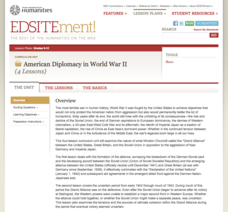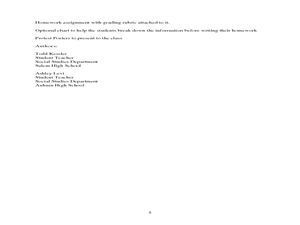National Endowment for the Humanities
American Diplocmacy in World War II
The end of World War II saw the world deeply changed over the last few years. Four thorough lessons explore post-war Europe, America, and Asia through reading assignments and discussion questions about the Grand Alliance and the signing...
Curated OER
Cold War Chronology
In this Cold War activity, students examine the chronological list of important events between 1945 and 1991. Students then respond to 7 short answer questions based on the chronology.
Curated OER
The Korean War - A Time Line Activity
Students create a Korean War time line. They identify, describe, and label nine of the key events and turning points of the Korean Conflict. They include all nine events listed on the direction sheet, contain a title, and have at...
Curated OER
Coup to Revolution: U.S. foreign Policy in Iran
Students read and discuss the Iran country Profile from the CIA World Factbook. They describe the current relationship between the United States and Iran. Students complete additional readings, and answer questions about them. They...
Curated OER
Vietnam: A Divided Nation
Eleventh graders examine events leading up to and during the Vietnam War. They research assigned topics utilizing interviews, Powerpoint presentations, timelines, and collages in their presentations.
Curated OER
1968 – A Generation in Revolt
Tenth graders compare and contrast the revolts that took place around the world in 1968. In this global studies lesson, 10th graders research the youth revolts that took place in Paris, Prague, and Chicago in 1968 and create posters and...
Curated OER
American Pop Icons
Pupils analyze art and decide if the images are an attempt to celebrate or criticize American Popular Culture of the fifties and sixties and discuss how successful "Pop Art" mirrored society. Students also discuss the difference between...








